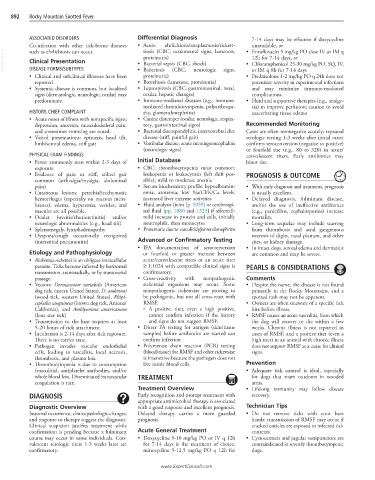Page 1778 - Cote clinical veterinary advisor dogs and cats 4th
P. 1778
892 Rocky Mountain Spotted Fever
ASSOCIATED DISORDERS Differential Diagnosis 7-14 days may be effective if doxycycline
unavailable, or
Co-infection with other tick-borne diseases • Acute ehrlichiosis/anaplasmosis/rickett- • Enrofloxacin 5 mg/kg PO slow IV or IM q
siosis (CBC, oculoneural signs, lameness,
VetBooks.ir Clinical Presentation • Bacterial sepsis (CBC, shock) • Chloramphenicol 25-30 mg/kg PO, SQ, IV,
such as ehrlichiosis can occur.
proteinuria)
12h for 7-14 days, or
DISEASE FORMS/SUBTYPES
or IM q 8h for 7-14 days
proteinuria)
• Clinical and subclinical illnesses have been • Babesiosis (CBC, neurologic signs, • Prednisolone 1-2 mg/kg PO q 24h does not
reported. • Borreliosis (lameness, proteinuria) potentiate severity in experimental infections
• Systemic disease is common, but localized • Leptospirosis (CBC; gastrointestinal, renal, and may minimize immune-mediated
signs (dermatologic, neurologic, ocular) may ocular, hepatic changes) complications.
predominate. • Immune-mediated diseases (e.g., immune- • Fluid and supportive therapies (e.g., analge-
mediated thrombocytopenia, polyarthropa- sia) to improve perfusion; caution to avoid
HISTORY, CHIEF COMPLAINT thy, glomerulonephritis) exacerbating tissue edema
• Acute onset of illness with nonspecific signs; • Canine distemper (ocular, neurologic, respira-
depression, anorexia, musculoskeletal pain, tory, gastrointestinal signs) Recommended Monitoring
and sometimes vomiting are noted. • Bacterial discospondylitis, intervertebral disc Cases are often seronegative acutely; repeated
• Varied presentations: epistaxis, head tilt, disease (stiff, painful gait) serologic testing 1-3 weeks after initial onset
limb/scrotal edema, stiff gait • Vestibular disease, acute meningoencephalitis confirms seroconversion (negative to positive)
(neurologic signs) or fourfold rise (e.g., 80 to 320) in acute/
PHYSICAL EXAM FINDINGS convalescent titers. Early antibiotics may
• Fever: commonly seen within 2-3 days of Initial Database blunt rise.
exposure • CBC: thrombocytopenia most common;
• Evidence of pain or stiff, stilted gait leukopenia or leukocytosis (left shift pos- PROGNOSIS & OUTCOME
common (arthralgia/myalgia, abdominal sible); mild to moderate anemia
pain) • Serum biochemistry profile: hypoalbumin- • With early diagnosis and treatment, prognosis
• Cutaneous lesions: petechial/ecchymotic emia, azotemia, low Na/Cl/K/Ca levels, is usually excellent.
hemorrhages (especially on mucous mem- increased liver enzyme activities • Delayed diagnosis, fulminant disease,
branes), edema, hyperemia, vesicles, and • Fluid analysis (joint [p. 1059] or cerebrospi- and/or the use of ineffective antibiotics
macules are all possible. nal fluid [pp. 1080 and 1323] if affected): (e.g., penicillins, cephalosporins) increase
• Ocular (uveitis/chorioretinitis) and/or mild increase in protein and cells, initially mortality.
neurologic abnormalities (e.g., head tilt) neutrophils, then monocytes • Long-term sequelae may include scarring
• Splenomegaly, lymphadenopathy • Proteinuria due to vasculitis/glomerulonephritis from thrombosis and acral gangrenous
• Dyspnea/cough occasionally recognized necrosis of digits, nasal planum, and other
(interstitial pneumonitis) Advanced or Confirmatory Testing sites, or kidney damage.
• IFA documentation of seroconversion • In intact dogs, scrotal edema and dermatitis
Etiology and Pathophysiology or fourfold or greater increase between are common and may be severe.
• Rickettsia rickettsii is an obligate intracellular acute/convalescent titers or an acute titer
parasite. Ticks become infected by horizontal ≥ 1:1024 with compatible clinical signs is PEARLS & CONSIDERATIONS
transmission, transstadially, or by transovarial confirmatory.
passage. • Cross-reactivity with nonpathogenic Comments
• Vectors: Dermacentor variabilis (American rickettsial organisms may occur. Some • Despite the name, the disease is not found
dog tick, eastern United States), D. andersoni nonpathogenic rickettsiae are proving to primarily in the Rocky Mountains, and a
(wood tick, western United States), Rhipi- be pathogenic, but not all cross-react with spotted rash may not be apparent.
cephalus sanguineus (brown dog tick, Arizona/ RMSF. • Owners are often unaware of a specific tick
California), and Amblyomma americanum ○ A positive titer, even a high positive, bite before illness.
(lone star tick) cannot confirm infection if the history • RMSF causes an acute vasculitis, from which
• Transmission to the host requires at least and signs do not suggest RMSF. the dog will recover or die within a few
5-20 hours of tick attachment. • Direct FA testing for antigen (skin/tissue weeks. Chronic illness is not reported in
• Incubation is 2-14 days after tick exposure. samples) before antibiotics are started can cases of RMSF, and a positive titer (even a
There is no carrier state. confirm infection high titer) in an animal with chronic illness
• Pathogen invades vascular endothelial • Polymerase chain reaction (PCR) testing does not support RMSF as a cause for clinical
cells, leading to vasculitis, local necrosis, (blood/tissue) for RMSF and other rickettsiae signs.
thrombosis, and plasma loss. is insensitive because the pathogen does not
• Thrombocytopenia is due to consumption live inside blood cells. Prevention
(vasculitis), antiplatelet antibodies, and/or • Adequate tick control is ideal, especially
whole blood loss. Disseminated intravascular TREATMENT for dogs that roam outdoors in wooded
coagulation is rare. areas.
Treatment Overview • Lifelong immunity may follow disease
DIAGNOSIS Early recognition and prompt treatment with recovery.
appropriate antimicrobial therapy is associated
Diagnostic Overview with a good response and excellent prognosis. Technician Tips
Seasonal occurrence, clinicopathologic changes, Delayed therapy carries a more guarded • Do not remove ticks with your bare
and response to therapy suggest the diagnosis. prognosis. hands; transmission of RMSF may occur if
Clinical suspicion justifies treatment while cracked cuticles are exposed to infected tick
confirmation is pending because a fulminant Acute General Treatment contents.
course may occur in some individuals. Con- • Doxycycline 5-10 mg/kg PO or IV q 12h • Cystocentesis and jugular venipuncture are
valescent serologic titers 1-3 weeks later are for 7-14 days is the treatment of choice; contraindicated in severely thrombocytopenic
confirmatory. minocycline 5-12.5 mg/kg PO q 12h for dogs.
www.ExpertConsult.com

